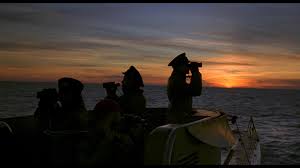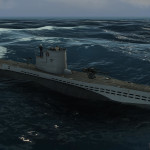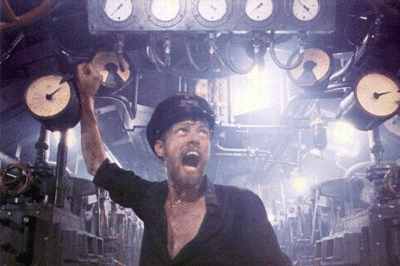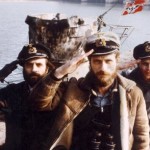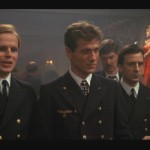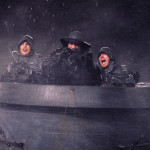Another classic to review, this time the 3 hour 20 minute director’s cut of Wolfgang Petersen‘s 1981 epic tale of a German U-boat (specifically a U-96 of Type VIIC) and its crew, Das Boot. Very few war films make it anywhere near my long-term favourites, but this is one of the finest and most acclaimed, and with good reason.
The movie is about the relationship between the crew, the enemy, the German military machine, with one another, with their leaky, claustrophobic submarine – a floating coffin if ever there were one, and ultimately with the enemy they are commissioned to destroy at all costs, even when to do so is suicidal. As the titles say, 40,000 men were sent out on U-boats, and 30,000 did not return. The crews were only too aware of the risks and the near-certainty of death. It invades their every waking moment, and their uneasy sleep too.
As with all great war films, this is a very human story of a crew of “boys” growing up under the authoritative and paternal stewardship of the 30-year old veteran Kapitänleutnant, played with skill and self-control by the admirable Jürgen Prochnow. It starts with the crew letting their hair down in a cabaret bar in La Rochelle, getting drunk and letting off steam, but this pleasure is short-lived, particularly a drunken and mockingly sarcastic speech by fellow-captain Philipp Thomsen (Otto Sander.) Very soon they are back on duty and ready for the daunting prospect of going to sea for an unknown duration.

 The benefit of the director’s cut, and indeed the TV mini-series into which the movie was also made, is that it demonstrates the value of character development for each member of the crew, and a rounded perspective of their feelings towards each other and their predicament under the watchful eye of narrator and war correspondent Leutnant Werner (Herbert Grönemeyer), who begins with enthusiasm, taking pictures of everybody in action, but as the movie progresses falling prey to weariness and a dark sense of foreboding, just like many of his colleagues.
The benefit of the director’s cut, and indeed the TV mini-series into which the movie was also made, is that it demonstrates the value of character development for each member of the crew, and a rounded perspective of their feelings towards each other and their predicament under the watchful eye of narrator and war correspondent Leutnant Werner (Herbert Grönemeyer), who begins with enthusiasm, taking pictures of everybody in action, but as the movie progresses falling prey to weariness and a dark sense of foreboding, just like many of his colleagues.
This in turn helps the audience identify with the vulnerable youngsters doing the jobs of men, and helps to ratchet up the tension as the mission progresses – each man knowing that that moment could be their last. One of the crew had to flip, but to the Captain’s dismay it is the experienced Chief Mechanic, Johann, known as “The Ghost” (Erwin Leder) who suffers the anguish of a mental breakdown. Survival requires a cool head but the fear factor is always there, the elephant in the sub.
Even the long periods boredom inbetween drills and enemy engagements is fraught with an unspoken fear, but when the engagements come the tension is palpable. They sit 30 metres below, straining to hear the enemy vessels above the surface, eyes turned upwards to a man, in sweaty silences lest they be heard. But depth charges often follow, their explosions rocking the boat, blowing fuses, gaskets blowing, water fizzing into the narrow body of the boat. But the youngsters do their jobs with grim calm, execute running repairs and keep the structure intact, because if they don’t then everyone drowns.
This is a tale of two missions: the first is to intercept and destroy enemy convoys crossing the Atlantic, the lifeblood of the allied war mission. It’s a game of underwater chess, with any false move punishable by death. If a lone ship looks too good to be true, it probably is – reckless attack might result in a trap. Small wonder the captain is cagey, but even a battle-scarred veteran like him can make mistakes.
The boat suffers a barrage of detonations, but makes it back to base only to discover mission no 2: to use stealth to weave a path through the British blockade of the Mediterranean in order to stop convoys reaching port. This is mission impossible, but the captain has a plan. That it does not work is not his fault – blame the suicidal orders from high command. The worst of all is that the stricken sub descends, past the 90m testing limit, way past the depths past which a human would be crushed by the sheer pressure, beyond the end of the dial until they are stopped by the ocean floor, miraculously in one piece.
This is certain death, but with the help of repairs to make her water-tight, and all the knowledge and experience the crew can muster, their one-chance chance of escape works, against all odds. As they return to La Rochelle, the crew are elated – survival after weeks aboard a death-trap, greeted as heroes upon their return. But then the sting in the tale: an air raid, the vessel that saved them all sinking slowly, all but Werner killed. The Captain watches the tragic demise of his boat with his own dying eyes.
If ever you wanted to experience the magic of cinema, of how it can create a truly authentic atmosphere. Yes, I accept some of the special effects with miniatures are not up to today’s CGI effects, but it was 1981! The scenes inside the U-boat are however as good as anything ever recorded, and fully worthy of the praise lavished upon this movie.
Another factor worth considering is that this is a German film about German navy vessels, in contrast to the usual war tales told by the winners. No American propaganda about the evil Nazis, but just another crew of frightened young men doing the duty their country has bestowed on them. This is war seen from the perspective of those who know what they are doing is madness but they have to do what they have to do. Their youngsters are no better or worse than ours. Such is the madness of war.
Das Boot is a movie you really should see at least once in a lifetime, since you are there with the crew throughout. Superlative film-making by Petersen, recommended for the right reasons. Not a laugh a minute but as honest a movie about war as you will ever come across.

